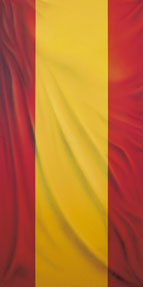|
Herbert Warmuth At
first glance, the «Fahnenbilder» (flag pictures) and similar
pictures by Herbert Warmuth’s (born 1960) represent moving fabric.
The folds are painted in a deceptively real way. On second glance, this
spatial illusion crumbles: The border where color fields meet remains
strictly vertical or horizontal, and your glance lands soberly on the
two-dimensional picture surface. Since Cezanne left his canvas untreated
in a number of paintings, there has been a demand to remember the picture
surface in the painted spatial illusion. Reality literally shines through
the illusion. As opposed to the traditional peephole perspective, painting’s
relationship to reality exists here in that the observer always remains
conscious of the fact that he is indeed standing in front of a flat canvas—regardless
of how deeply the painted illusion pulls his glance towards the picture.
Warmuth’s work is part of this tradition. His pictures create an
illusion, only to destroy it in the next instant. The fabrics which appear
to fall in folds—Warmuth repeatedly uses patterned materials as his
canvas—produce more than just a spatial illusion: The illusion of
motion that has been frozen. Motion indicates life, whether the folds
are the result of wind, whether it is the body mass or simply because
of the weight of the material. The illusion of motion lends the pictures
life. Moreover, Warmuth’s colors have the delicacy of Old Masters.
The newer camouflage pictures are refined: The artist paints the patterns
of camouflaging tarpaulin that military units use to conceal their equipment.
As such the illusion of motion and its subsequent destruction are no longer
separate in terms of time and successive perception, as they were in the
flag pictures. At almost the same time, the illusion can appear as the
destruction of illusion, and likewise the destruction as an illusion.
At the point where your glance changes, both can seem to be the case.
This effect succeeds by way of the unique patterns that appear almost
simultaneously as both flat and three-dimensional. Using camouflage to
create an illusion fits in with this concept very nicely. Camouflage on
the other hand is about making volume flat — or from a painting point
of view—about the problem in art that was mentioned at the beginning.
It is however peculiar if the camouflage colors are no longer green and
earthy, but festive. The manner in which soldiers and their equipment
mimic is by adapting their colors to match that of the ground. So on what
background would such gaudy camouflage colors fit? And who or what would
cover them so deliciously in a war? A civilian festival? A festival during
the war? In spite of the war? In protest against the war? Conceal? Quite
the opposite, the camouflage colors would be an indication of life, they
would not conceal it, but give it away. With Warmuth, nothing turns out
to be what it initially appears.Burkhard Brunn
|
